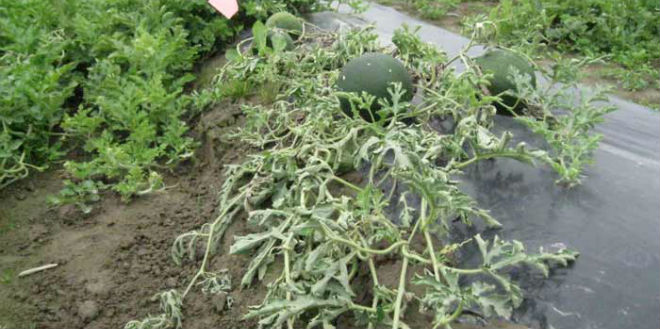Apr 19, 2017Plastic mulch used to control verticillium wilt in watermelons
Verticillium wilt, caused by the soilborne fungus Verticillium dahliae, is a significant disease affecting watermelon (Citrullus lanatus) production in Washington State. This field study at three locations in Washington in 2015 compared verticillium wilt susceptibility, fruit yield and quality of nongrafted watermelon, and grafted plants grown with black plastic and clear plastic mulch.
Overall for grafting treatments, area under disease progress curve (AUDPC) values were higher for nongrafted ‘TriX Palomar’ (765) than for ‘TriX Palomar’ grafted onto ‘Super Shintosa’ (132), ‘Tetsukabuto’ (178), or ‘Just’ (187). Overall for mulch, the AUDPC value was higher for plants grown with black plastic mulch (385) than for plants grown with clear plastic mulch (237).
Overall for location, the AUDPC value was lowest at Eltopia (84), intermediate at Othello (182), and highest at Mount Vernon (680). At season end, more Verticillium microsclerotia were present in stems of nongrafted ‘TriX Palomar’ than in grafted treatment stems at Eltopia and Mount Vernon, but not at Othello. Differences in microsclerotia presence occurred only in the top or scion portion of the stem, but not in the graft union, rootstock, or crown portions of the stem.
There was no difference due to mulch in regard to Verticillium microsclerotia detected in stem assays. After harvest, V. dahliae soil density under black plastic mulch increased 6-fold at Eltopia, 4.7-fold at Othello, and 1.9-fold at Mount Vernon. In contrast, V. dahiae soil density under clear plastic mulch was nearly identical to the level at planting at each location (<1, 2.6, and 27 cfu/g at Eltopia, Othello, and Mount Vernon, respectively).


There was a significant interaction between grafting and location for fruit yield such that there was no difference at Eltopia and Othello, but at Mount Vernon, yield of nongrafted ‘TriX Palomar’ was lower (7.4 kg/plant) than for grafted plants (average 13.0 kg/plant). The number and weight of marketable fruit per plant were higher at Othello (4.0 and 27.65 kg/plant, respectively) than at Eltopia (2.0 and 12.23 kg/plant, respectively) and Mount Vernon (2.2 and 11.63 kg/plant, respectively).
Fruit firmness was greater overall for all three grafted treatments (average 2.67 N) than for nongrafted ‘TriX Palomar’ (2.20 N), but there was no difference in total soluble solids (TSS) or lycopene content of fruit due to grafting. Yield, fruit firmness, and TSS did not differ due to mulch type; however, lycopene content was greater for plants grown with black plastic mulch than with clear plastic mulch at Eltopia.
There was no difference in TSS due to location, but fruit firmness was lower at Eltopia and Othello (2.20 and 2.44 N, respectively) than at Mount Vernon (3.00 N), whereas lycopene content was less at Mount Vernon (27.85 μg·g−1) than at Eltopia or Othello (38.58 and 36.54 μg·g−1).
The results of this study indicate that although verticillium wilt symptoms were visible in watermelon plants when V. dahliae level was 50 cfu/g of soil, yield was greater for grafted plants and for plants grown with clear plastic mulch.
— Sahar Dabirian, Debra Inglis and Carol A. Miles, Washington State University
Source: HortScience















